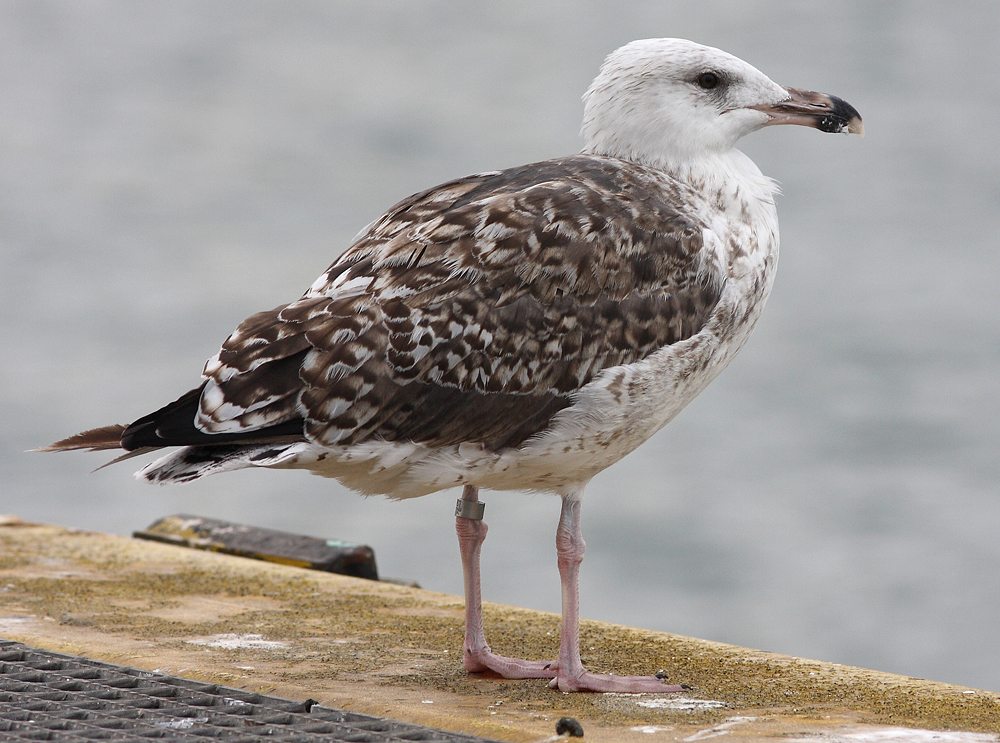 Great Black-backed Gull (Larus marinus)
Great Black-backed Gull (Larus marinus)
(last update: July 12, 2015)
Great Black-backed Gull (Larus marinus) DEH 3112361 2cy, August 28 2012, Boulogne sur Mer, France (50.44 N - 01.35 E). Picture Jean-Michel Sauvage.
Bird of unknown origin; ringed on 17 September 2011 as 1cy by Andreas Buchheim, on board at ship "M/V Hydrograf" at "Ankerplatz 9" (+55°08'00,0''N +06°30'00,0'E') in the North Sea (see map below).
below: 2cy marinusDEH 3112361 September 12 2012, Boulogne sur Mer, France (50.44 N - 01.35 E). Picture Jean-Michel Sauvage.
P7 / -. Rectrices fully grown.

below: 2cy marinusDEH 3112361 August 28 2012, Boulogne sur Mer, France (50.44 N - 01.35 E). Picture Jean-Michel Sauvage.
P7 / P10. Outer rectrices still growing.

This is the first Great Black-backed Gull ringed in Germany at sea, and observed at Boulogne sur mer. It has been present on the port of Boulogne sur mer on 28.08.2012 and 12.09.2012. The ringer, Andreas Buchheim is involved in research related to wind farms at sea and sometimes he catches birds at the ship. Andreas: "So far I've caught and banded 12 marinus, 1 argentatus, 1 ridibundus and 220 fulmars. Another ringed marinus was observed in Denmark, the ridibundus was ringed in Finland."
Offshore wind turbines in Germany:
Germany became one of the first producers of wind energy in the world. Currently, thirty offshore projects site are under study; more than three-quarters are located in the North Sea and a little less than a quarter in the Baltic Sea. Yet each year, during periods of migration, hundreds of millions of birds of nearly 250 species cross these two seas to reach their nesting sites in North America, Asia or northern Scandinavia and Finland. The seas are also crossed by wintering birds that want to reach Central Europe or Southern Africa. Finally, it's used as a resting area or feeding place for many species of birds. The offshore projects in these seas will probably include some hundreds of turbines.
IMPACT OF WIND
We can distinguish several factors and responses of birds to the construction of wind turbines. Each factor leads to a series of physical and ecological impacts, as detailed below.
1. Avoidance response in the presence of the wind turbine
The wind represents a barrier for birds in their movements both local (foraging) or global (eg migration). A number of birds will prefer to avoid wind, so flight out of the wind rather than through it. This behavior helps avoid the risk of collision mortality but leads to an increase of the distance flown to bypass the obstacle and thus a higher energy expenditure. The magnitude of the impact depends on the species, size, spacing of turbines, the magnitude of the additional energy expenditure and the ability of birds to compensate for this extra energy needed.
During the construction of an offshore wind farm near an area generally exploited by birds as feeding area, avoiding this area therefore represents a loss of habitat. This loss of foraging habitat requires birds to perform a new search for sites, requiring additional energy expenditure.
However, it is recognized in the literature that the reproductive success and survival of a species is related to the physical condition of an individual. Therefore, this energy is most important may directly impact the reproduction and survival of the species.
2. Loss or degradation of habitats, creation of artificial habitats
During the construction of an offshore wind farm on an area generally exploited by birds as feeding area, it is therefore a loss of habitat. This loss of foraging habitat requires birds to perform a new search sites, requiring additional energy expenditure. The impact of energy expenditure is the same as that described above.
The presence of an offshore wind platform for some species may represent a gain of habitats, including use as altars. This habitat can help reduce the energy expenditure of birds and therefore indirectly to promote the survival and reproduction of these species.
3. Collision mortality
The presence of a wind farm in an area frequented by birds or crossing can lead to death of the latter by collision with rotors. The collision causes direct mortality of birds and can impact the survival of the species in the medium or long term depending on the sensitivity of the species and its workforce. When the weather is bad and visibility is low, the birds can be attracted to light. The attractiveness of wind and could increase the risk of collision of birds that are approaching too close to the turbines. And migration periods when weather conditions are bad, collisions due to light attraction may be very important.
SOURCE
